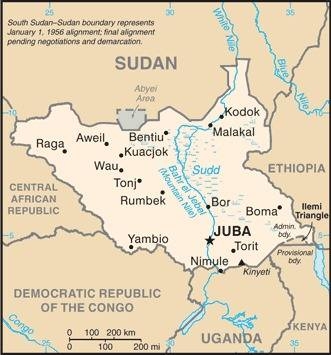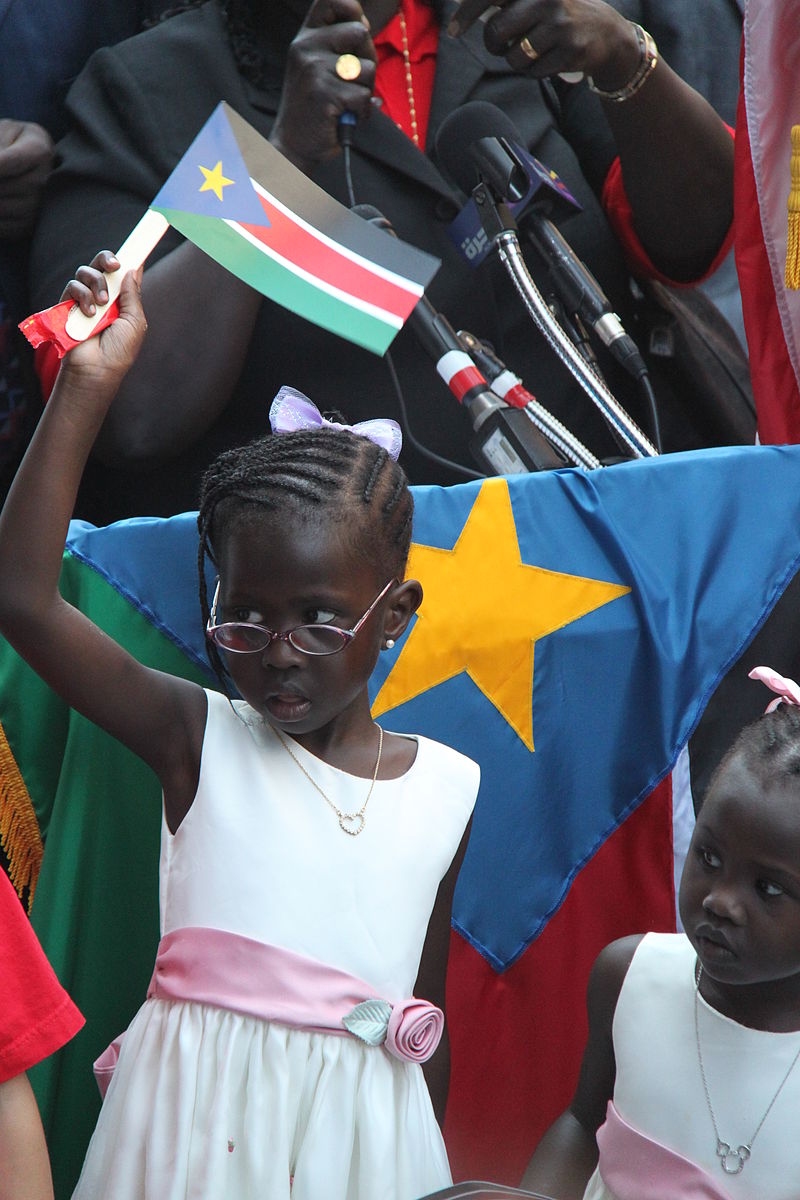223 South Sudan

Three equal horizontal bands of black (top), red, and green; the red band is edged in white. A blue isosceles triangle based on the hoist side contains a gold, five-pointed star. Black represents the people of South Sudan, red the blood shed in the struggle for freedom, green the verdant land, and blue the waters of the Nile. The gold star represents the unity of the states making up South Sudan.
Flag courtesy of the CIA World Factbook

Map courtesy of the CIA World Factbook

A South Sudanese girl at independence festivities
Government
According to Britannica, the creation of the semiautonomous region of southern Sudan was provided for by the 2005 Comprehensive Peace Agreement (CPA) that ended the long-running civil war between the north and the south. The region was administered under the constitution for southern Sudan, promulgated in December 2005, as well as the country’s national interim constitution, promulgated in July 2005. The latter document provided for the handling of any conflicts that might occur between the two concurrent levels of government. Both documents were superseded by the transitional constitution prepared for governing South Sudan upon its 2011 secession from Sudan.
Under the 2011 transitional constitution, South Sudan was a republic. Executive power was vested in the president and the vice president, who was appointed by the president. Upon independence, the directly elected incumbent president of the southern Sudan region became president of the country for a four-year term. Legislative power was bicameral, comprising the National Legislative Assembly (NLA) and the Council of States. Upon independence, the NLA body consisted of members of the previous regional legislative body, the South Sudan Legislative Assembly, and South Sudanese who had seats in Sudan’s National Assembly. The majority of NLA members were directly elected; the rest were elected from closed lists to ensure proportional representation for women and various other groups. Upon independence, the Council of States consisted of all South Sudanese who had been elected by state legislatures to seats in Sudan’s Council of States, as well as 20 members appointed by South Sudan’s president. NLA and Council of States members were to serve four-year terms.
Following the civil war that broke out in December 2013, a peace agreement signed in August 2015 provided for the creation of a transitional power-sharing government that would include members of the current administration as well as members from the rebels. It was implemented in April 2016 and was intended to function for 30 months, with, among its tasks, the goal of organizing elections 60 days prior to the end of the transitional period. The incumbent president remained in place and appointed a first vice president, selected from the rebel group, in accordance with the terms of the peace agreement. After the creation of the transitional government, the administration had 90 days to transform the National Legislative Assembly into the Transitional National Legislative Assembly, which included the members of the former plus an additional 68 members: 50 from the South Sudan Armed Opposition, 1 former detainee, and 17 from other political parties. The other legislative body, the Council of States, remained unchanged in the new transitional government.
For administrative purposes, South Sudan is divided into states. At independence there had been 10 states, but a December 2015 decree by the president abolished them and replaced them with 28 new states. The new administrative structure was highly controversial, as it interfered with the power-sharing arrangements as outlined in the fragile peace agreement signed by the government and rebel forces in August 2015.
The constitution for South Sudan provides for an independent judiciary. The Supreme Court is the highest court. The country also has three Courts of Appeal, and each state has a High Court, County Courts, and town and city courts.
Civil / National Aviation Authority (CAA/NAA)
South Sudan Civil Aviation Authority (SSCAA) was established in 2006 after the CPA Agreement during Unity Government as the directorate of Air Transport under Sudan Civil Aviation Authority, later after independent of South Sudan in 2011, SSCAA was officially formed and recognized by ICAO has its 193rd Member and key aviation player in accordance with the requirements and developments in the Aviation sector locally, regionally and globally.
Airspace
SkyVector – Google Maps – ADS-B Exchange
ICAO countries publish an Aeronautical Information Publication (AIP). This document is divided into three parts: General (GEN), En Route (ENR) and Aerodromes (AD). ENR 1.4 details the types of airspace classes they chose to adopt from classes A through G. South Sudan AIP
Drone Regulations
Civil Aviation Act with UAS mentioned – excerpts below
3. Interpretation.
In this Act, unless the context otherwise requires, the following words and expressions shall carry the meaning assigned to them respectively:
“Accident” means any occurrence associated with the operation of an aircraft which, in the case of a manned aircraft, takes place between the time any person boards the aircraft with the intention of flight until such time as all such persons have disembarked, or in the case of an unmanned aircraft, takes place between the time the aircraft is ready to move with the purpose of flight until such time as it comes to rest at the end of the flight and the primary propulsion system is shut down, in which: —
(a) a person is fatally or seriously injured as a result of: —
(i) being in the aircraft,
(ii) direct contact with any part of the aircraft, including parts which have become
detached from the aircraft, or
(iii) direct exposure to jet blast, except when the injuries are from natural causes, self- inflicted or inflicted by other persons, or when the injuries are to stowaways hiding outside the areas normally available to the passengers and crew; or
(b) the aircraft sustains damage or structural failure which:—
(i) adversely affects the structural strength, performance or flight characteristics of the aircraft; and
(ii) would normally require major repair or replacement of the affected component, except for engine failure or damage, when the damage is limited to a single engine, (including its cowlings or accessories), to propellers, wing tips, antennas, probes, vanes, tires, brakes, wheels, fairings, panels, landing gear doors, windscreens, the aircraft skin (such as small dents or puncture holes), or for minor damages to main rotor blades, tail rotor blades, landing gear, and those resulting from hail or bird strike (including holes in the radome); or
(c) the aircraft is missing or is completely inaccessible;
…
“Serious incident” means an incident involving circumstances indicating that there was a high probability of an accident associated with the operation of an aircraft which, in the case of a manned aircraft, takes place between the time any person boards the aircraft with the intention of flight until such time as all such persons have disembarked, or in the case of an unmanned aircraft, takes place between the time the aircraft is ready to move with the purpose of flight until such time as it comes to rest at the end of the flight and the primary propulsion system is shut down;
“Unmanned aircraft” means an aircraft operated with no pilot on board.
ii. for aerial work;
64. Unmanned aircraft
(1) An [unmanned aircraft] shall not be flown over the territory of South Sudan without special authorization by the Authority and in accordance with the terms of such authorization.
(2) A person shall not cause or permit an [unmanned aircraft] to endanger any person or property.
(3) South Sudan shall ensure that the flight of [unmanned aircraft] in the regions open to civil aircraft shall be controlled to avoid danger to civil aircraft.
76. Flying from unmanned aerodrome
(1) Where an aircraft is flown from any unmanned aerodrome or point within South Sudan to another unmanned aerodrome or point within South Sudan, the pilot in-command of such aircraft and the operator of such aerodrome shall be required to provide such information as the Authority may specify.
(2) The information under subsection (1) shall include details of the flight and the nature of the operations.
Advanced Air Mobility (AAM)
Short Essay Questions
Question 1
You have been hired by a Drone Startup Company. Your boss has immediately assigned this job to you.
They need you to prepare a one-page memo detailing the legalities of using a drone to film in South Sudan.
They need you to mention any national laws and local ordinances.
They specifically want to know what airspace you will be operating in and whether or not you need an airspace authorization.
Does it matter whether or not you are a citizen of the country?
Lastly, there is a bonus for you if, as you scroll through this chapter, you find any typos or broken links!
Question 2
Do you need a certificate to fly UAS?
If so, how do you obtain one?
Are there fees associated with this?
If so, how much?
Question 3
May you operate beyond visual line of sight?
If so, what procedures must you follow?
Question 4
Does the country have UAM/AAM laws? If so, describe, citing the exact law.
Question 5
Are you aware of any new laws or policies not mentioned above? If so, describe, citing the exact law or policy.

